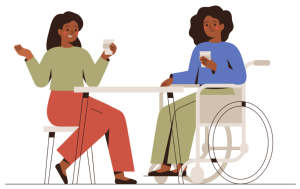Workplace Communication & Safety for Physical Disabilities
Employers often have concerns related to employing people with disabilities, especially regarding communication and safety. It’s important to be prepared to answer questions your industry partner may have.
Many types of apparent and non-apparent disabilities can impact mobility, such as paralysis, muscular dystrophy, arthritis, and spinal cord injury. Mobility impairments can include lower body and/or upper body impairments, which may involve limited to no use of the limbs.
Communication
Explain to your industry partner how you effectively communicated and worked with your student. The best advice to give your industry partner is to not make assumptions about communication needs but instead just ask. Below are some strategies for communicating with someone who has a physical disability.
- Approach as with anyone else. Offer to shake their hand, if appropriate to do so. Extend your hand and if the person is unable to extend their hand, reach further instead of withdrawing. Even if they have limited use of their hand, or wear an artificial limb, it is respectful to offer a handshake.
- When speaking to someone who uses a wheelchair or scooter, take a step back so you have eye contact. If your conversation lasts more than a few minutes, consider sitting so you and the person are at the same eye level.
- Speak directly to the person. If someone is accompanying the person (e.g., pushing a wheelchair) speak to the person, rather than the companion.
- Converse normally. If you don’t understand something, ask the person to repeat what was said. It’s okay to use common expressions, such as “I have to run.” If the person would prefer you avoid particular phrases, it is best to honor their request.
- Use people-first language. Refer to “a person with a disability” or “person who uses a wheelchair” rather than “the disabled person” or “the disabled". Avoid saying handicapped, crippled, physically-challenged, differently-abled, etc.
- Be considerate. Respect personal space and assistive devices:
- Don’t lean on a person’s wheelchair while speaking to them.
- Ask for permission before moving an assistive device if it is not being used, as the individual may have positioned it nearby purposefully.
- Do not engage with a service animal without first asking the individual.
Safety
Safety is a concern many employers have when hiring individuals with physical disabilities. Many of the things already in place for employee safety will benefit an individual with a physical disability. The following strategies will help ensure safety for all employees, including those with physical disabilities.
- Equipment for Safety.
- Use both visual and auditory warning systems to notify of a malfunction or emergency issue.
- Use visual indicators to show steps in a process and when complete.
- Use convex mirrors in blind spot areas so everyone can avoid collisions.
- Position emergency shut-off switches to be reachable by everyone.
- Prepare for Safety.
- Use a buddy system during emergencies as a no-cost strategy to ensure the safety of all workers.
- Have well marked exits that are designated on a posted floor plan placed low enough to be visible by those in wheelchairs.
- Include in your evacuation plan how you will assist persons with physical disabilities on all levels of a building.
- Designate a safety area in the event evacuation cannot be made from any non-ground level floor. Two-way radios or a telephone in these areas can help ensure that communication is available. Appoint someone to inform emergency officials arriving on the scene of the person’s location.
- The use of evacuation equipment, safety areas, and communication tools should be included as part of regularly scheduled drills.
Additional Resources
Printable (PDF) Version of Tip Sheet
Developed in conjunction with Technological Education Center for Deaf and Hard-of-Hearing Students (DeafTEC), based at the Rochester Institute of Technology. 